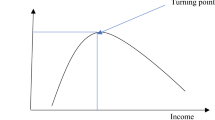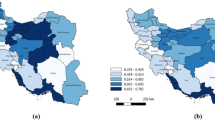Abstract
Nowadays, environment problem has become the international hot issue. Experts and scholars pay more and more attention to the energy efficiency. Unlike most studies, which analyze the changes of TFEE in inter-provincial or regional cities, TFEE is calculated with the ratio of target energy value and actual energy input based on data in cities of prefecture levels, which would be more accurate. Many researches regard TFP as TFEE to do analysis from the provincial perspective. This paper is intended to calculate more reliably by super efficiency DEA, observe the changes of TFEE, and analyze its relation with TFP, and it proves that TFP is not equal to TFEE. Additionally, the internal influences of the TFEE are obtained via the Malmquist index decomposition. The external influences of the TFFE are analyzed afterward based on the Tobit models. Analysis results demonstrate that Heilongjiang has the highest TFEE followed by Jilin, and Liaoning has the lowest TFEE. Eventually, some policy suggestions are proposed for the influences of energy efficiency and study results.






Similar content being viewed by others
Notes
DEA-SBM refers to Data Envelopment Analysis Slacks-Based Measure.
Da Hinggan Ling region data is not included in it.
Science-technology three-expense refers to the subsidized trial manufacture of new products, interlocutory costs of experiments, and major scientific projects allowance in order to support the development of science and technology.
References
Caves Douglas W, Diewert WE (1982) The economic theory of index numbers and the measurement of input, output, and productivity. Econometrica 50(6):1393–1414
Coelli BTJ (1996) A guide to DEAP version 2.1: a data envelopment analysis (computer) program. CEPA working paper 96/8. Department of Econometrics, University of New England, Armidale
Coelli TJ, Rao DSP, Battese GE (1998) An introduction to efficiency and productivity analysis. Kluwer Academic Publishers, Boston
Diewert WE, Caves Douglas W (1982) Multilateral comparisons of output, input, and productivity using superlative index numbers. Economic Journal 92(365):73–86
Fan D, Wang W (2013) Analysis of total factor energy efficiency and potential of the energy-saving and emission-abating in regional of China—based on SBM model of undesired output. Mathematics in Practice and Theory 43(7):12–21
Fan Y, Liao H, Wei Y (2007) Can market oriented economic reforms contribute to energy efficiency improvement evidence from China. Energy Policy 35:2287–2295
Färe Rolf, Grosskopf Shawna, Lindgren Björn, Roos Pontus (1994) Productivity developments in Swedish hospitals: a Malmquist output index approach. data envelopment analysis: Theory, methodology, and applications:227–235
Farrell MJ (1957) The measurement of productive efficiency. Journal of Royal Statistical Society 120:253–281
Ferrier GD, Lovell CA (1990) Measuring cost efficiency in banking: econometric and linear programming evidence. J Econ 46(2):229–245
Hu J, Wang S (2006) Total-factor energy efficiency of regions in China. Energy Policy 34(17):3206–3217
Khazzoom JD (1980) Economic implications of mandated efficiency in standards for household appliances. Energy J 1(4):21–40
Li M, Tao W (2017) Review of methodologies and polices for evaluation of energy efficiency in high energy-consuming industry. Appl Energy 187:203–215
Li L, Zhou Y (2006) Can technical changes improve the energy efficiency?—based on the empirical test of industrial sector. Management World 10:82–89
Liu D, Zhao S, Guo Y (2015) Energy efficiency and its determinants of Western China: total factor perspective. China Environ Sci 35(6):1911–1920
Meng F, Su B, Thomson E, Zhou D, Zhou P (2016) Measuring China’s regional energy and carbon emission efficiency with DEA models: a survey. Appl Energy 183:1–21
Qu X’e (2009) China’s interprovincial total factor energy efficiency change decomposes. The Journal of Quantitative & Technical Economics 8:29–43
Rosegrant M W, Evenson R E. Total factor productivity and sources of long-term growth in Indian agriculture. International Food Policy Research Institute (IFPRI), Washington, DC, 1995.
Shi D (2003) Industrial structure changes effects on energy consumption. Economic Theory and Business Management 8:30–32
Shi D (2006) Regional differences in China’s energy and conservation potentials. China Industrial Economy 10:49–58
Shi F, Shen K (2008) Journal of World Economy 9:49–59
Sun J, Xiao C (2012) An empirical analysis on total factor productive energy efficiency of Yangtze River Delta region. China Population, Resources and Environment 22(12):67–72
Wang W, Fan D (2012) Influential factors convergence of total factor energy efficiency in China based on the Malmqulist-Luenberger index. Resources Science 34(10):1816–1824
Wang Q, Zhou D (2008) An empirical study on the change of total factor energy efficiency in China. Management World 26(7):74–80
Wang Q, Fan J, Wu S (2014a) Spatial-temporal variation of regional energy efficiency and its causes in China, 1990–2009. Geogr Res 33(1):43–56
Wang J, Shi D, Zhang C (2014b) The impact of energy prices on energy efficiency—an empirical study based on global data. Economy Management 12:13–23
Wei C, Shen M (2007a) Energy efficiency and the influences: the empirical study based on the DEA model. Management World (8):66–76
Wei C, Shen M (2007b) Energy efficiency and energy productivity: a comparison based on the panel data by province. The Journal of Quantitative & Technical Economics 9:110–121
Wu Q, Cheng J (2006) Changes and factors decomposition of Chinese energy consumption industry: 1980–2004. Economic Theory and Business Management 10:34–40
Zeng X (2010) Energy efficiency, potential of CO2 emission reduction and its determinants across Chinese regions. China Environ Sci 10:1432–1440
Acknowledgments
This work was supported by the National Social Science Foundation of China (Grant564 No.13&ZD171).
Author information
Authors and Affiliations
Corresponding author
Additional information
Responsible editor: Philippe Garrigues
Rights and permissions
About this article
Cite this article
Ma, X., Liu, Y., Wei, X. et al. Measurement and decomposition of energy efficiency of Northeast China—based on super efficiency DEA model and Malmquist index. Environ Sci Pollut Res 24, 19859–19873 (2017). https://doi.org/10.1007/s11356-017-9441-3
Received:
Accepted:
Published:
Issue Date:
DOI: https://doi.org/10.1007/s11356-017-9441-3




